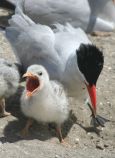 Wanted Dead or Alive
Wanted Dead or Alive
We developed a state-space mark-recapture-recovery model that incorporates multiple recovery types and state uncertainty to estimate survival of an anadromous fish species. We apply the model to a dataset of out-migrating juvenile steelhead trout (Oncorhynchus mykiss) tagged with passive integrated transponders, recaptured during outmigration, and recovered on bird colonies in the Columbia River basin (2008-2014). Recoveries on bird colonies are regularly ignored in survival studies because the river reach of mortality is often unknown, which we model as a form of state uncertainty. Median outmigration survival from release to the lower river (river kilometer 729 to 75) ranged from 0.27 to 0.34, depending on year. Recovery probabilities were frequently >0.20 in the first river reach following tagging, indicating that one out of five fish that died in that reach was recovered on a bird colony. Integrating dead recovery data provided increased parameter precision, estimation of where birds consumed fish, and survival estimates across larger spatial scales. More generally, these modeling approaches provide a flexible framework to integrate multiple sources of tag recovery data into mark-recapture studies.
- N. Hostetter, B. Gardner, A. Evans, B. Cramer, Q. Payton, K. Collis, and D. Roby
Click here to see manuscript



